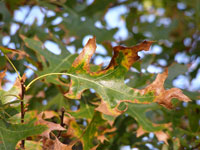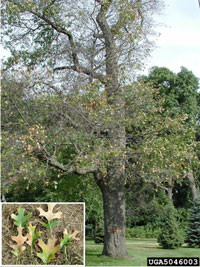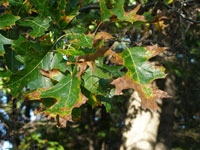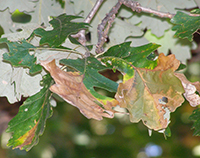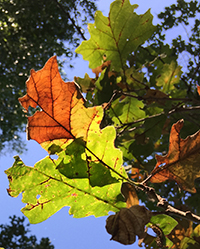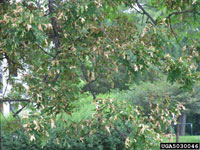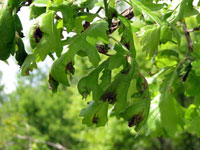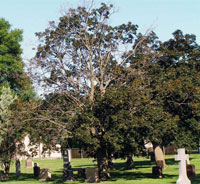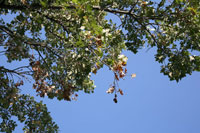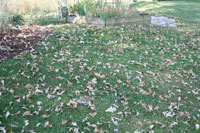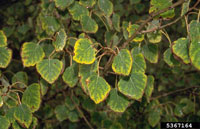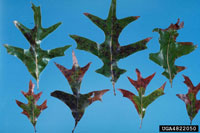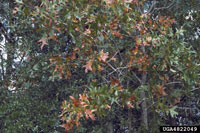Extension > Garden > Diagnose a problem > What's wrong with my plant? > Deciduous Trees > Oak > Leaf edges brown, center of leaf green
Oak > Leaves > Leaf edges brown, center of leaf green
1 of 7
Oak wilt
Ceratocystis fagacearum
- Leaves wilt, leaf edges and tips turn brown, with a green center
- In red oak group symptoms are first seen in the top of the canopy, disease progresses to the entire canopy and kills tree in 1 to 3 months
- Infected trees drop their leaves
- In white oak group symptoms appear in one branch, disease progresses slowly from 1 to 5 years before death
- In white oak group - Peel back layer of bark on symptomatic branch to reveal brown streaking on wood
- Symptoms appear in whole groups of trees as infection spreads through root graft
- More information on Oak wilt
2 of 7
Bur oak blight
Tubakia iowensis
- Infects only bur oaks - small acorn variety
- Spring and early summer, leaf veins on lower leaf surface have dark brown dots or short lines
- Mid-summer and fall, random lengths of leaf vein turn brown; some expand into brown wedge shaped areas on leaves
- Leaves may turn completely brown, some drop early
- Small raised black dots form on the petiole (stem) of infected leaves
- Some leaves remain attached through winter
- Symptoms appear in lower, inner canopy first. Disease progresses upward and outward over multiple seasons
- More information on Bur oak blight
3 of 7
Oak anthracnose
Discula quercina
- Leaves have scattered brown, irregular spots that can coalesce into nearly completely brown leaves
- Affected leaves become wrinkled, cupped or curled especially around leaf edges
- On severely infected trees, leaves fall off early in the season, trees soon sends out new leaves
- Damage is most common on lower and interior branches
- Damage most common in spring as leaves are growing during wet weather
- Most affected are trees within white oak group (white oak, bur oak, swamp white oak)
- More information on Oak anthracnose
4 of 7
Stem girdling roots
- Affected trees commonly exhibit water-stress symptoms such as marginal leaf scorch, wilting, sudden leaf fall
- Leaves stunted, exhibit poor summer color, change color and drop early in fall
- Affected trees commonly exhibit excessive and abnormal winter damage including frost cracks and dieback
- A root circling the trunk of the tree may be seen at the soil line
- Trunk may be sunken in or compressed where it contacts the root
- If girdling root is below ground, the trunk will lack the natural widening or flare at the soil line so will go straight into the earth like a telephone pole; trees often exhibit an abnormal lean
- More information on Stem girdling roots
5 of 7
Drought
- Leaf margins and branch extremities usually brown and wilt first
- Leaves often yellow (chlorotic)
- Uniform wilting or browning of leaves throughout the tree
- Severe drought stress may cause dieback of individual branches
- Drought-stressed trees and shrubs often drop their leaves abnormally early
- More information on watering trees and shrubs
6 of 7
Deicing salt injury
- Soil salt damage causes leaf edges or margins to appear burnt or scorched progressing toward the mid-vein
- Soil salt damage can mimic nutrient deficiencies, e.g., yellowing foliage on deciduous plants
- Salt spray causes branches to become tuft-like (a.k.a. witches’ broom)
- Run-off salt kills roots which results in die-back of most branches
- Affected trees leaf out later than other non-infected trees
- All deicing damage most noticeable in spring
- More information on Deicing salt injury
7 of 7
Bacterial leaf scorch
Xylella fastidiosa
- Leaf edges and tips turn brown, with a green center, leaves appear scorched
- Symptoms often appear on one to a few branches, the entire canopy slowly becomes affected over several years
- Often only one tree within a cluster is affected
- Symptoms often appear in August or September
- Common on trees within the red oak group (red oak, northern pin oak)
- More information on Bacterial leaf scorch



